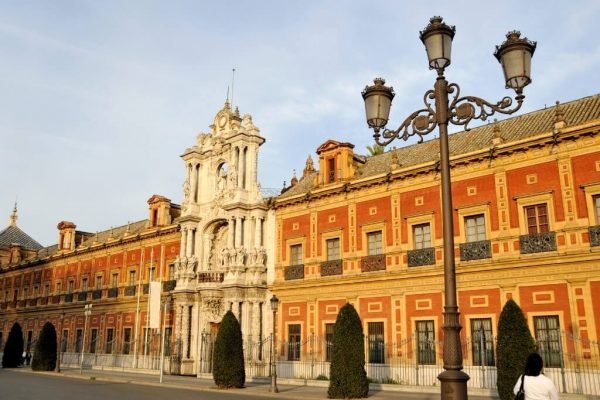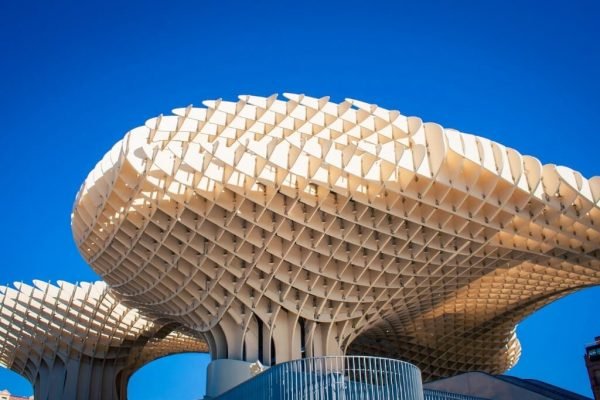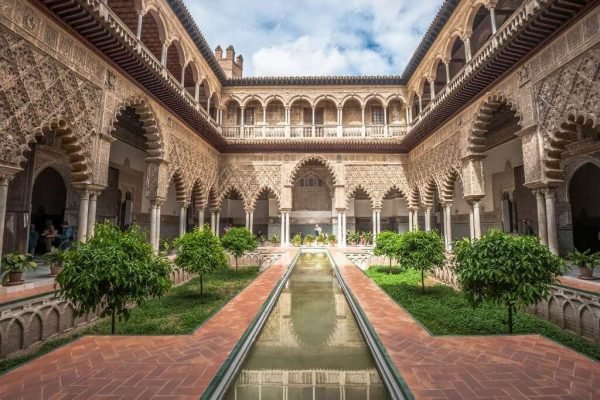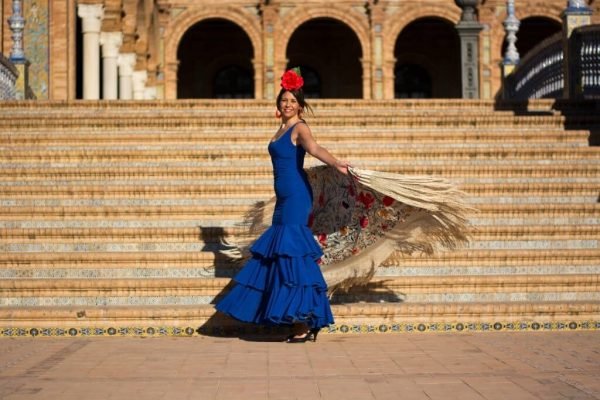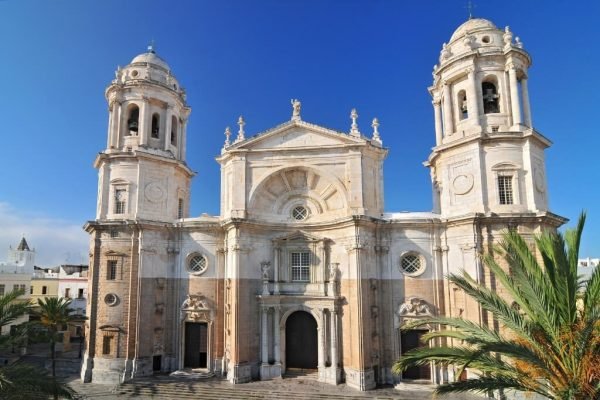Coach Tour to Seville and Cadiz with Pepe Tours
PEPE TOURS
Coach Tour to Seville and Cadiz with Pepe Tours
PEPE TOURS
Visit Seville, Jerez and Cadiz with English speaking guides
A coach tour to Seville and Cadiz with Pepe Tours. Our journey takes us across Andalusia, travelling from east to west to reach Seville, the capital of Andalusia. We then visit Cadiz, the most ancient city of the west, with over 3,000 years of history.
Departure days
Departures: on request
The tour to Seville, Jerez de la Frontera and Cadiz includes:
– Travel Insurance
– Transportation by bus with air-conditioning, video, reclining seats etc.
– 2 nights in 4-star hotels based on half board (breakfast and dinner)
– English speaking tour guide
– Visit of a winery at Jerez
– Visits with local guides
Itinerary of the coach holiday to Seville and Cadiz:
Day 1.
Departure from our terminal heading west along the A-92 motorway crossing Andalusia from one side to the other, enjoying breath-taking landscapes and learning about the cultural and historical heritage that the romans, phoenicians and moors left us. Arrival to Seville, capital city of Andalusia. We’ll enjoy a panoramic tour to discover its highlights and then, led by a local guide we’ll do a guided tour of the city centre. Transfer to hotel, dinner and accommodation.
Day 2.
After breakfast, we’ll head southward searching the blue of the Atlantic Coast. Our first stop will be at Jerez de La Frontera known worldwide thanks to its wine, the birthplace of flamenco and land of Andalusian horses. Upon arrival we’ll enjoy a guided tour of this magnificent city followed by a wine tasting in one of its world-famous wineries where you can learn the secrets and taste the famous Jerez wine (sherry). Our tour continues to Cadiz where our local guide awaits for us for an in-depth cultural visit of the oldest city in Western Europe founded by the Phoenicians in the 2nd century BC. Transfer to hotel, dinner and accommodation.
Day 3.
Breakfast at the hotel. Departure along the Costa del Sol. We’ll do a stop at Puerto Banus in Marbella. Free time at your disposal to enjoy the marvellous seaside resort or if you like shopping, note that Marbella is a shopper’s paradise as you will find every designer boutique you can imagine. Continue back to our terminal and end of our service.
Information about destination:
Seville is situated on the banks of the river Guadalquivir. It possesses a rich Arabian legacy and the only river port in Spain, historically being a hub of commerce with the Americas. It’s a joy to experience the hustle and bustle of the capital of Andalusia with its quaint little streets and square in the old town which comprises an interesting collection of buildings. The old town contains no less than three UNESCO World Heritage Sites.
Seville Cathedral (consecrated in 1507) has, since its construction, been known as the Magna Hispalensis. It’s the largest Gothic Cathedral and the third largest church in the world. In 1928 the Cathedral was declared a National Monument and in 1987 it was registered by UNESCO as a World Heritage Site. It is home to many important archives and libraries, including the Colombina Library in the Patio de los Naranjos (the inner court of the orange trees). Its architectural features are the sum of consecutive expansions and modifications since the initial construction on the site of the Great Mosque, built by the Almohades in the 12th century. Nowadays the only remnants visible of the mosque are the Patio de los Naranjos and the minaret, the Giralda, where we have a wonderful view over the city. The Cathedral contains many beautiful artworks.
The Plaza de España (Spain Square) is built in a regionalist style (a mixture of art-deco within neo-mudejar, gothic and renaissance revival). The materials which are used are brick and ceramics. Around the square are 48 alcoves, in alphabetical order, dedicated to the Spanish provinces, decorated with ceramic tiles representing historic scenes, together with the coat of arms and the map of the province. A little river circles the square, with four bridges representing the four kingdoms of which the Spanish crown consisted: Castilla, Leon, Navarra and Aragon. Nowadays the buildings are the seat of different public offices, the civil and also the military government of Seville.
Cadiz, with its 3,000-year-old history, is the most southern city in Europe. It’s a maritime city, full of light. The Walls of the Puertas de Tierra clearly separate the modern city from the old. The old city is full of little streets, squares and typical places such as: ‘La Viña’, the old fishermen district where you can try the famous ‘pescaito frito’ (fried fish); the ‘Mentidero’ district or ‘Santa Maria’ quarter famous for Flamenco singing (e.g. San Juan de Dios square) and the ‘El Populo’ district of the old medieval city.
The old town is a historic centre where we find the most important monuments, the commercial district (ideal for shopping) and the ‘La Caleta’ beach with a road over the reef (flanked by the Santa Catalina and San Sebastian castles). The new district has modern buildings, avenues, a Beach Boulevard as well as the beautiful beaches of La Victoria, Santa Maria del Mar and Cortadura.
Cadiz is a lively city with a typical Andalusian character. In order to really know Cadiz, you need to wander through its streets, taking time to talk to the locals, walk through the gardens and avenues, enjoy the atmosphere, the terraces and busy bars.
Cadiz is the oldest continuously-inhabited city in Spain and indeed one of the oldest in southwest Europe. Founded by the Phoenicians around 1,100 B.C. it was home to a plethora of cultures including the Greeks, Romans, Visigoths and Arabs. King Alfonso X the Wise reconquered the City in 1262 and had a Cathedral built on the same site where the old Arabian mosque was previously situated.
The city has a close association with Columbus as it was his departure point on his second and fourth voyages to discover America and also the point of return for his third voyage (he departed from San Lucar de Barrameda).
During the 18th century Cadiz became one of the most important cities in Spain because of the creation of the ‘Casa de Contratacion’ for commerce with ‘The Indies’. From then on it became a liberal, cosmopolitan city and one of the most important commercial centres in Europe. These liberal ideas were secured in 1812, the year when the government was formed and the first Spanish Constitution was written, which made Cadiz the capital of Spain between 1810 and 1813.
The most important (historically and artistically significant) buildings are located in the old town of Cadiz:
Please note that
* Pepe Tours reserves the right to alter and modify the itinerary and the order of the excursions for organizational reasons.. Depending on hotel availability or in case of last-minute bookings, Pepe Tours may replace the scheduled hotels by others of the same category (see list of scheduled hotels in this link).




